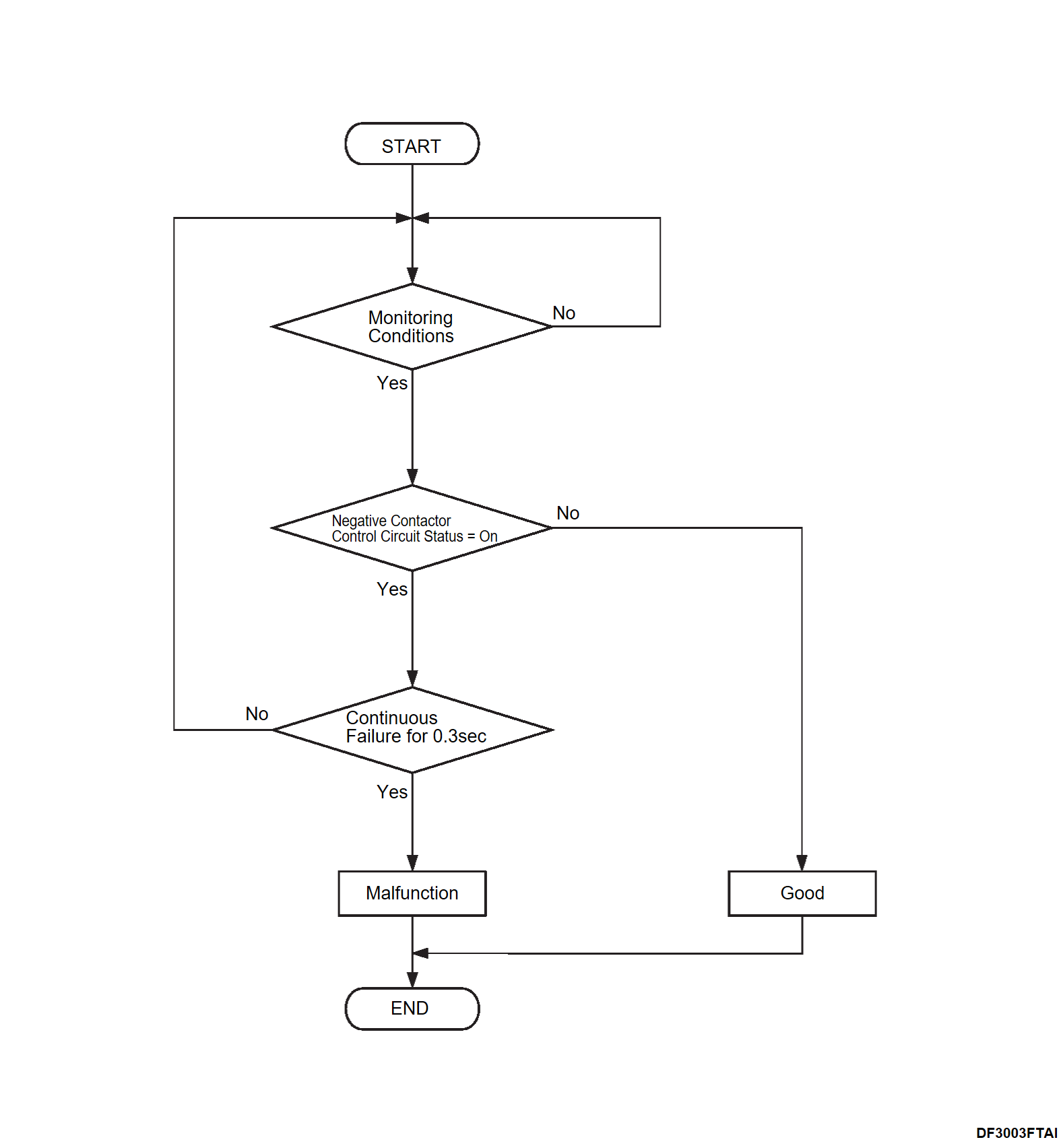DTC No. P0AE0-00 Hybrid/EV Battery Negative Contactor Control Circuit High
| danger |
|
MONITOR EXECUTION
Continuous
MONITOR EXECUTION CONDITIONS (Other monitor and Sensor)
Other Monitor (There is no temporary DTC set in memory for the item monitored below)
- Not applicable
Sensor (The sensor below is determined to be normal)
- Not applicable
DTC SET CONDITIONS
Check Condition
- The PHEV-ECU power supply voltage is 9.0 V or more.
- Drive battery negative contactor control circuit activation command: OFF
- The EV power source relay drive signal: ON
Judgment Criterion
- Drive battery negative contactor control circuit status is in ON condition for 0.3 second or more.
OBD-II DRIVE CYCLE PATTERN
- Refer to OBD-II Drive Cycle OBD-II DRIVE CYCLE
 .
.
TROUBLESHOOTING HINTS
- Damaged wiring harness and connectors
- Malfunction of the junction box No. 2
- Malfunction of the PHEV-ECU
DIAGNOSIS
Required Special Tools:
- MB992744: Vehicle communication interface-Lite (V.C.I.-Lite)
- MB992745: V.C.I.-Lite main harness A
- MB992747: V.C.I.-Lite USB cable short
- MB992748: V.C.I.-Lite USB cable long
- MB991223: Wiring harness set
- MB992006: Extra fine probe
1.Resistance measurement at PHEV-ECU connector (CNT- terminal)
(1) Disconnect the PHEV-ECU connector (B508), and measure at the wiring harness side.
(2) Measure the resistance between the PHEV-ECU connector (CNT- terminal) and body ground.
OK: 36 ± 3 Ω [at 23°C (74.3°F)]
Is the check result normal?
2.Check of continuity at drive battery connector (control wiring harness connector) (terminal No. 18)
(1) Disconnect the drive battery connector (control wiring harness connector), and measure at the wiring harness side.
(2) Check the continuity between the drive battery connector (control wiring harness connector) (terminal No. 18) and body ground.
OK: Continuity exists (2 Ω or less)
Is the check result normal?
3.Check of open circuit in CNT- line between PHEV-ECU and drive battery
4.Test the OBD-II drive cycle.
(1) Carry out a test drive with the drive cycle pattern. Refer to OBD-II Drive Cycle OBD-II DRIVE CYCLE .
.
 .
.(2) Check the DTC.
Is the DTC set?
 The trouble can be an intermittent malfunction (Refer to General Information - How to Use Troubleshooting/Inspection Service Points, How to Cope with Intermittent Malfunctions HOW TO COPE WITH INTERMITTENT MALFUNCTIONS
The trouble can be an intermittent malfunction (Refer to General Information - How to Use Troubleshooting/Inspection Service Points, How to Cope with Intermittent Malfunctions HOW TO COPE WITH INTERMITTENT MALFUNCTIONS ).
).5.Drive battery main contactor (N) check
| danger |
|
(1) Disassemble the drive battery (Refer to SERVICE PROCEDURE ).
).
 ).
).(2) Check the junction box No. 2 (Refer to CHECK ON JUNCTION BOX No. 2 ).
).
 ).
).Is the check result normal?
 Repair the connector(s) or wiring harness inside the drive battery.
Repair the connector(s) or wiring harness inside the drive battery. Replace the junction box No. 2 (Refer to JUNCTION BOX NO.2 REMOVAL AND INSTALLATION
Replace the junction box No. 2 (Refer to JUNCTION BOX NO.2 REMOVAL AND INSTALLATION ). Then,
). Then, 
6.Check wiring harness and connectors for damage.
Check the wiring harness and connectors in CTN- line between the PHEV-ECU connector and drive battery connector for damage.
Is the check result normal?
7.Test the OBD-II drive cycle.
(1) Carry out a test drive with the drive cycle pattern. Refer to OBD-II Drive Cycle OBD-II DRIVE CYCLE .
.
 .
.(2) Check the DTC.
Is the DTC set?
 Replace the PHEV-ECU (Refer to PHEV-ECU REMOVAL AND INSTALLATION
Replace the PHEV-ECU (Refer to PHEV-ECU REMOVAL AND INSTALLATION ), then go to
), then go to 
 The trouble can be an intermittent malfunction (Refer to General Information - How to Use Troubleshooting/Inspection Service Points, How to Cope with Intermittent Malfunctions HOW TO COPE WITH INTERMITTENT MALFUNCTIONS
The trouble can be an intermittent malfunction (Refer to General Information - How to Use Troubleshooting/Inspection Service Points, How to Cope with Intermittent Malfunctions HOW TO COPE WITH INTERMITTENT MALFUNCTIONS ).
).8.Test the OBD-II drive cycle.
(1) Carry out a test drive with the drive cycle pattern. Refer to OBD-II Drive Cycle OBD-II DRIVE CYCLE .
.
 .
.(2) Check the DTC.
Is the DTC set?
 Disassemble the drive battery (Refer to SERVICE PROCEDURE
Disassemble the drive battery (Refer to SERVICE PROCEDURE ). After the disassembly, repair the connector(s) or wiring harness inside the drive battery. Then,
). After the disassembly, repair the connector(s) or wiring harness inside the drive battery. Then, 
 The procedure is complete.
The procedure is complete.9.Test the OBD-II drive cycle.
(1) Carry out a test drive with the drive cycle pattern. Refer to OBD-II Drive Cycle OBD-II DRIVE CYCLE .
.
 .
.(2) Check the DTC.
Is the DTC set?
 Retry the troubleshooting.
Retry the troubleshooting. The procedure is complete.
The procedure is complete.![[Previous]](../../../buttons/fprev.png)
![[Next]](../../../buttons/fnext.png)
